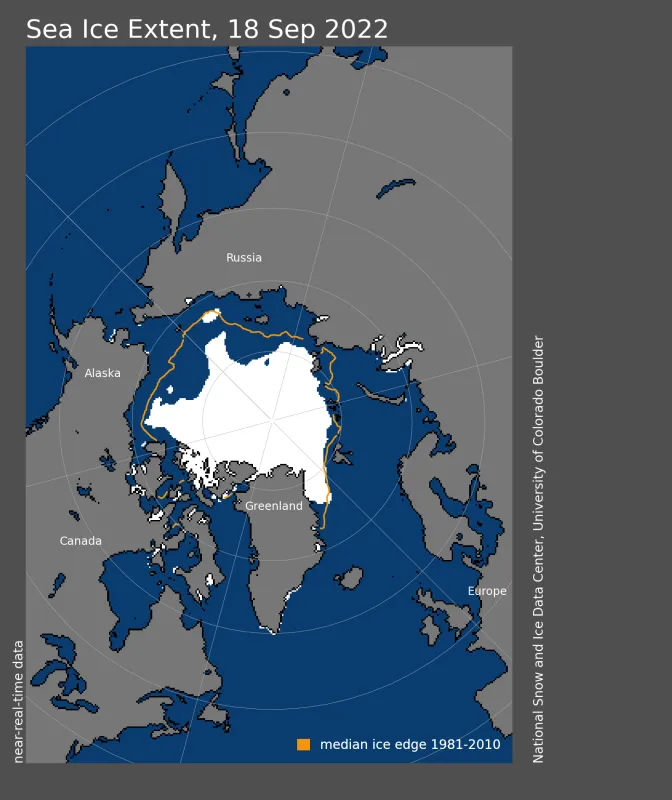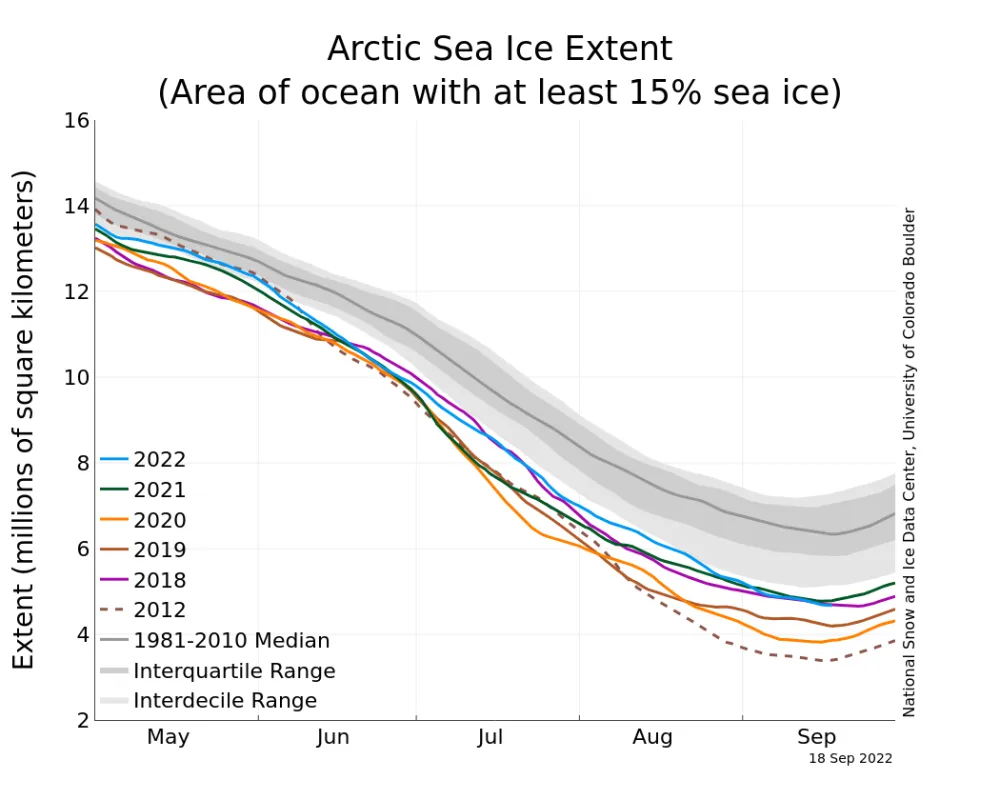On September 18, Arctic sea ice likely reached its annual minimum extent of 4.67 million square kilometers (1.80 million square miles). The 2022 minimum is tied for tenth lowest in the nearly 44-year satellite record, with 2018 and 2017. The last 16 years, from 2007 to 2022, are the lowest 16 sea ice extents in the satellite record.
In the Antarctic, sea ice extent has hit record lows through most of the growth season. Starting in early August, sea ice began expanding rapidly, exemplifying the strong degree of variability in Southern Hemisphere sea ice. As such it is too early to assume that the maximum has been reached as storms may still expand or compact the extended ice edge. The maximum for Antarctic sea ice typically occurs in late September or early October.
Please note that this is a preliminary announcement. Changing winds or late-season melt could still reduce the Arctic ice extent, as happened in 2005 and 2010. NSIDC scientists will release a full analysis of the Arctic melt season, and discuss the Antarctic winter sea ice growth, in early October.
Overview of conditions
On September 18, sea ice reached its annual minimum extent of 4.67 million square kilometers (1.80 million square miles) (Figure 1), tying for tenth lowest with 2018 and 2017. In response to the setting sun and falling temperatures, ice extent has begun expanding and will continue through autumn and winter. However, a shift in wind patterns or a period of late season melt could still push the ice extent lower.
The minimum extent was reached four days later than the 1981 to 2010 median minimum date of September 14. The interquartile range of minimum dates is September 11 to September 19.
Conditions in context
This year’s minimum set on September 18 was 1.28 million square kilometers (494,000 square miles) above the satellite-era record minimum extent of 3.39 million square kilometers (1.31 million square miles), which occurred on September 17, 2012 (Figure 2). It is also 1.55 million square kilometers (598,000 square miles) below the 1981 to 2010 average minimum extent, which is equivalent to twice the size of Texas.
In the 44-year-satellite record, 16 of the lowest minimums have all occurred in the last 16 years.
The overall, downward trend in the minimum extent from 1979 to 2022 is 12.6 percent per decade relative to the 1981 to 2010 average. The loss of sea ice is about 78,500 square kilometers (30,300 square miles) per year, equivalent to losing the size of the state of South Carolina or the country of Austria annually.
Sixteen lowest minimum Arctic sea ice extents (satellite record, 1979 to present)
| RANK | YEAR | MINIMUM ICE EXTENT | DATE | |
|---|---|---|---|---|
| IN MILLIONS OF SQUARE KILOMETERS | IN MILLIONS OF SQUARE MILES | |||
| 1 | 2012 | 3.39 | 1.31 | Sept. 17 |
| 2 | 2020 | 3.82 | 1.47 | Sept. 16 |
| 3 | 2007 2016 2019 | 4.16 4.17 4.19 | 1.61 1.61 1.62 | Sept. 18 Sept. 10 Sept. 18 |
| 6 | 2011 | 4.34 | 1.68 | Sept. 11 |
| 7 | 2015 | 4.43 | 1.71 | Sept. 9 |
| 8 | 2008 2010 | 4.59 4.62 | 1.77 1.78 | Sept. 19 Sept. 21 |
| 10 | 2018 2017 2022 | 4.66 4.67 4.67 | 1.80 1.80 1.80 | Sept. 23 Sept. 13 Sept. 18 |
| 13 | 2021 | 4.77 | 1.84 | Sept. 16 |
| 14 | 2014 2013 | 5.03 5.05 | 1.94 1.95 | Sept. 17 Sept. 13 |
| 16 | 2009 | 5.12 | 1.98 | Sept. 13 |
Values within 40,000 square kilometers (15,000 square miles) are considered tied. The 2021 value has changed from 4.72 to 4.77 million square kilometers (1.84 million square miles) when final analysis data updated near-real-time data.

